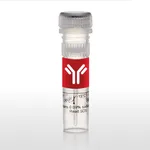
Thermo Fisher Scientific GRID2 (extracellular) Polyclonal Antibody
✨AI 추천 연관 상품
AI가 분석한 이 상품과 연관된 추천 상품들을 확인해보세요
연관 상품을 찾고 있습니다...
Applications
Tested Dilution
Publications
Western Blot (WB)
1:600
Immunocytochemistry (ICC/IF)
1:50
Product Specifications
Species Reactivity
Human, Mouse, Rat
Host/Isotype
Rabbit / IgG
Class
Polyclonal
Type
Antibody
Immunogen
(C)KMITTLFDTMRIE, corresponding to amino acid residues 206-218 of rat GluD2, Extracellular, N-terminus if (typeof window.$mangular === undefined || !window.$mangular) { window.$mangular = {}; } $mangular.antigenJson = \[{targetFamily:GRID2,uniProtId:Q63226-1,ncbiNodeId:10114,antigenRange:206-218,antigenLength:1007,antigenImageFileName:AGC-039-200UL_GRID2_Q63226-1_Rabbit.svg,antigenImageFileNamePDP:AGC-039-200UL_GRID2_Q63226-1_Rabbit_PDP.jpeg,sortOrder:2}\]; $mangular.isB2BCMGT = false; $mangular.isEpitopesModalImageMultiSizeEnabled = true;
View immunogen .st0{fill:#FFFFFF;} .st1{fill:#1E8AE7;}
Conjugate
Unconjugated Unconjugated Unconjugated
Form
Lyophilized
Concentration
0.8 mg/mL
Purification
Antigen affinity chromatography
Storage buffer
PBS, pH 7.4, with 1% BSA
Contains
0.05% sodium azide
Storage conditions
-20° C, Avoid Freeze/Thaw Cycles
Shipping conditions
Ambient (domestic); Wet ice (international)
Product Specific Information
Reconstitution: 25 µL, 50 µL or 0.2 mL double distilled water (DDW), depending on the sample size. The antibody ships as a lyophilized powder at room temperature. Upon arrival, it should be stored at -20C. The reconstituted solution can be stored at 4C for up to 1 week. For longer periods, small aliquots should be stored at -20C. Avoid multiple freezing and thawing. Centrifuge all antibody preparations before use (10000 x g 5 min).
Target Information
GRID2 is a member of the family of ionotropic glutamate receptors which are the predominant excitatory neurotransmitter receptors in the mammalian brain. The encoded protein is a multi-pass membrane protein that is expressed selectively in cerebellar Purkinje cells. A point mutation in the mouse ortholog, associated with the phenotype named lurcher, in the heterozygous state leads to ataxia resulting from selective, cell-autonomous apoptosis of cerebellar Purkinje cells during postnatal development. Mice homozygous for this mutation die shortly after birth from massive loss of mid- and hindbrain neurons during late embryogenesis. This protein also plays a role in synapse organization between parallel fibers and Purkinje cells. Alternate splicing results in multiple transcript variants encoding distinct isoforms. Mutations in this gene cause cerebellar ataxia in humans.
For Research Use Only. Not for use in diagnostic procedures. Not for resale without express authorization.
🏷️Thermo Fisher Scientific 상품 둘러보기
동일 브랜드의 다른 상품들을 확인해보세요

Thermo Fisher Scientific
Thermo Fisher Scientific NETO1 (extracellular) Polyclonal Antibody
742,000원

Thermo Fisher Scientific
Thermo Fisher Scientific GRIK4 (KA1) (extracellular) Polyclonal Antibody
742,000원

Thermo Fisher Scientific
Thermo Fisher Scientific GRID2 (extracellular) Polyclonal Antibody
742,000원

Thermo Fisher Scientific
Thermo Fisher Scientific GRID1 (extracellular) Polyclonal Antibody
742,000원

Thermo Fisher Scientific
Thermo Fisher Scientific VGLUT3 Polyclonal Antibody
742,000원
배송/결제/교환/반품 안내
배송 정보
| 기본 배송비 |
| 교환/반품 배송비 |
|
|---|---|---|---|
| 착불 배송비 |
| ||
| 교환/반품 배송비 |
| ||
결제 및 환불 안내
| 결제수단 |
|
|---|---|
| 취소 |
|
| 반품 |
|
| 환급 |
|
교환 및 반품 접수
| 교환 및 반품 접수 기한 |
|
|---|---|
| 교환 및 반품 접수가 가능한 경우 |
|
| 교환 및 반품 접수가 불가능한 경우 |
|
교환 및 반품 신청
| 교환 절차 |
|
|---|---|
| 반품 절차 |
|
